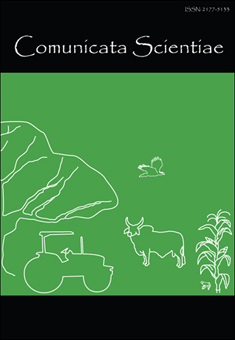Boron doses applied to soil during coffee development
DOI:
https://doi.org/10.14295/cs.v7i1.1097Palavras-chave:
coffee, micronutrient, toxicityResumo
The range between boron deficiency and toxicity in the coffee crop is narrow and the crop toxicity tolerance depends on the soil type, initial soil content and plant age. The objective of this study was to evaluate different levels of boron in the coffee crop during development and grown in a red clayey Oxisol. Treatments consisted of boron applications (zero; 2.48; 4.96; 9.92; 19.8 and 39.68 kg ha-1) in the boric acid form and applied to soil surface in the area of the tree crown projection. The six treatments were outlined in a randomized block design with four replications and ten plants per plot. The cultivar used was Catuaí IAC 144 with sixteen months old, grown in an Oxisol in Campinas, SP, Brazil. Foliar boron content was analyzed as a function of time by regression analysis. The levels in fruit and yield were analyzed by regression according to boron doses. It can be concluded that higher boron doses in the plant can be observed when fruits are at the first development stage. High doses can reduce yield productivity, being each kilogram of applied boron responsible for a reduction of 0.33 coffee bags. ha-1.
Downloads
Downloads
Publicado
Como Citar
Edição
Seção
Licença
A revista se reserva o direito de efetuar, nos originais, alterações de ordem normativa, ortográfica e gramatical, com vistas a manter o padrão culto da língua, respeitando, porém, o estilo dos autores. As provas finais serão enviadas aos autores. Os trabalhos publicados passam a ser propriedade da revista Comunicata Scientiae, ficando sua reimpressão total ou parcial, sujeita à autorização expressa da direção do periódico. Deve ser consignada a fonte de publicação original. Os originais não serão evolvidos aos autores. As opiniões emitidas pelos autores dos artigos são de sua exclusiva responsabilidade.




